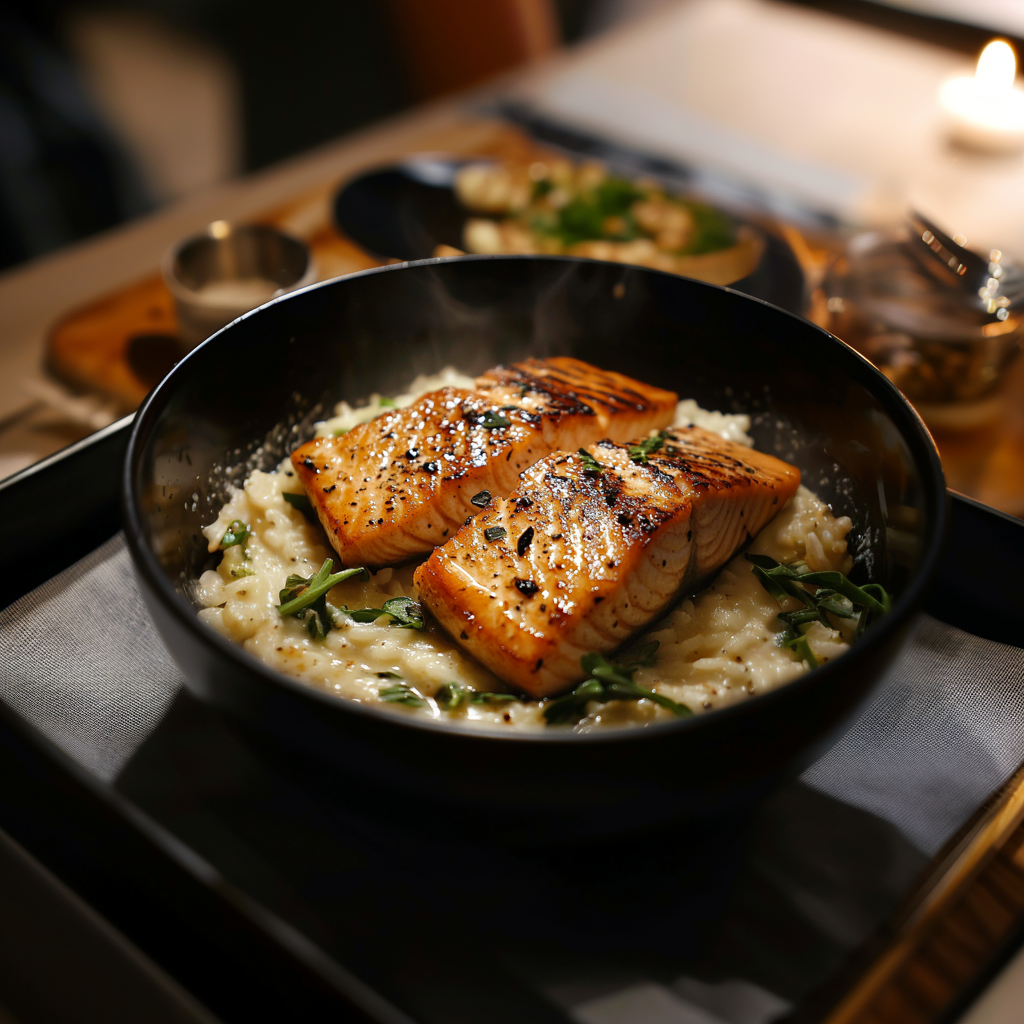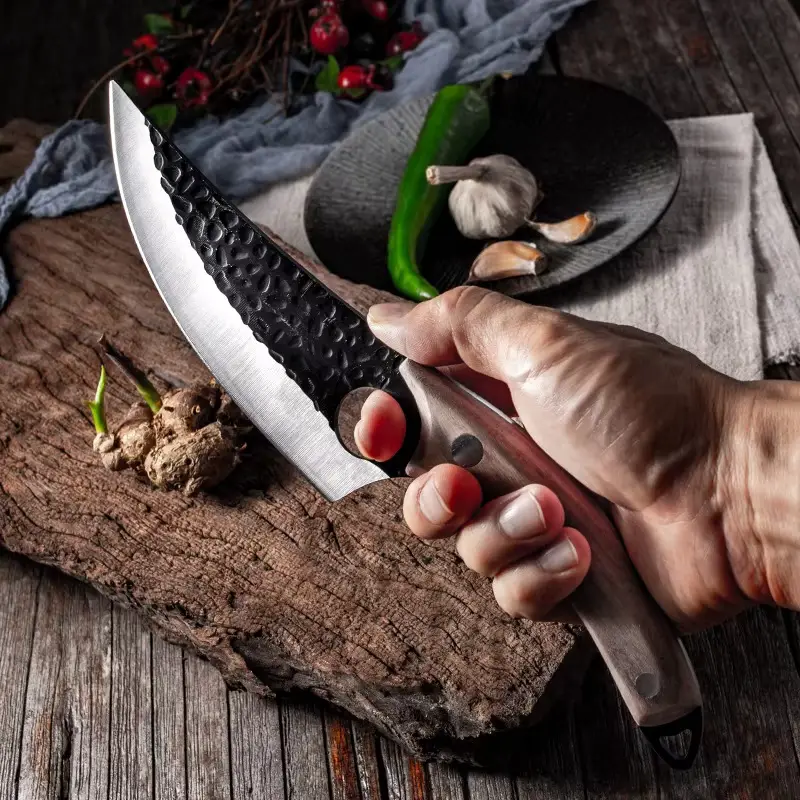Japanese-Style Risotto with Seared Salmon is a fusion dish that combines the creamy, comforting texture of Italian risotto with the delicate flavors of Japanese cuisine. By infusing traditional Japanese ingredients such as miso, mirin, and soy sauce into the risotto base, this dish takes on a new depth of flavor, creating a harmonious blend of umami and creamy richness. Paired with perfectly seared salmon, this risotto becomes a visually stunning and delicious main course that’s perfect for both casual dining and special occasions.
This dish is ideal for anyone who loves Japanese flavors but is also a fan of classic Italian risotto. The creamy rice is infused with dashi broth and miso, lending a savory and slightly sweet flavor profile, while a dash of soy sauce adds depth. The salmon is pan-seared to perfection, resulting in a crispy skin that contrasts beautifully with the creamy risotto. Garnished with green onions, sesame seeds, and a drizzle of soy or unagi sauce, this Japanese-Style Risotto with Seared Salmon is sure to become a new favorite.
Why You’ll Love This Recipe
This Japanese-Style Risotto with Seared Salmon is a comforting, flavorful dish that’s perfect for dinner. The combination of creamy, umami-rich risotto with crispy, tender salmon creates a balanced meal that’s packed with flavor. This dish is unique yet familiar, with the Japanese flavors transforming classic risotto into something fresh and exciting. If you love salmon, miso, and dashi, you’ll appreciate the depth of flavor in this dish. Plus, it’s surprisingly simple to make, and the ingredients are accessible, even for those new to Japanese cooking.
Preparation Time and Servings
- Prep Time: 15 minutes
- Cook Time: 30-35 minutes
- Total Time: 50 minutes
- Yield: 4 servings
- Serving Size: 1 portion
Nutritional Information (per serving)
- Calories: 580 kcal
- Carbohydrates: 52g
- Protein: 36g
- Fat: 24g
- Fiber: 2g
- Sugar: 3g
Ingredients
For the Japanese-Style Risotto
- 1 1/2 cups arborio rice (or Japanese short-grain rice)
- 4 cups dashi broth (or substitute with a mix of chicken broth and water if dashi is unavailable)
- 1 tablespoon white miso paste
- 1 tablespoon soy sauce
- 1 tablespoon mirin
- 1 small onion, finely chopped
- 2 cloves garlic, minced
- 2 tablespoons unsalted butter
- 2 tablespoons vegetable oil (for sautéing)
- 1/2 cup sake (or dry white wine as a substitute)
- 1/4 cup grated Parmesan cheese (optional, for creaminess)
For the Seared Salmon
- 4 salmon fillets (about 5 oz each), skin-on
- 1 tablespoon vegetable oil
- Salt and pepper, to taste
- 1 teaspoon soy sauce (for brushing)
Garnishes
- 2 green onions, thinly sliced
- Toasted sesame seeds
- Pickled ginger (optional)
- Drizzle of soy sauce or unagi sauce
Step-by-Step Instructions
Step 1: Prepare the Dashi Broth
- Heat the Dashi: In a medium saucepan, bring the dashi broth to a simmer. Keep it warm over low heat as you prepare the risotto. The warm broth will help cook the risotto evenly without cooling down the rice each time you add it.
Step 2: Sauté the Aromatics and Rice
- Sauté Onions and Garlic: In a large, heavy-bottomed skillet or saucepan, heat 2 tablespoons of vegetable oil over medium heat. Add the finely chopped onion and garlic, and sauté for 2-3 minutes until translucent and fragrant.
- Add the Rice: Add the arborio rice to the skillet, stirring constantly for about 2 minutes. This step toasts the rice, allowing it to absorb flavors and begin to release its starch, which contributes to the creaminess of the risotto.
Step 3: Deglaze and Begin Cooking the Risotto
- Deglaze with Sake: Pour in the sake, stirring constantly until the liquid is mostly absorbed. The sake adds a subtle flavor that enhances the risotto’s complexity. (If using white wine instead, follow the same process).
- Add Miso and Soy Sauce: Stir in the white miso paste and soy sauce, mixing until the miso dissolves and is evenly incorporated. These ingredients provide the base of umami flavor for the risotto.
Step 4: Gradually Add the Dashi Broth
- Cook the Risotto: Begin adding the warm dashi broth, one ladleful at a time, stirring frequently. Allow each ladleful of broth to be mostly absorbed before adding the next. This process typically takes 18-20 minutes for the rice to cook to an al dente texture. The risotto should be creamy, but the grains should retain a slight bite.
- Add Mirin: When you’re about halfway through adding the broth, add the mirin to the rice for a touch of sweetness.
Step 5: Finish the Risotto
- Check for Texture: Once the risotto reaches a creamy consistency and the rice is tender but not mushy, remove the skillet from the heat.
- Add Butter and Parmesan: Stir in the butter and Parmesan cheese (if using) for extra creaminess and richness. Taste and adjust the seasoning with additional soy sauce if needed.
Step 6: Sear the Salmon
- Season the Salmon: Pat the salmon fillets dry with paper towels. Season each fillet with salt and pepper on both sides.
- Heat the Oil: In a large non-stick skillet, heat 1 tablespoon of vegetable oil over medium-high heat until shimmering.
- Sear the Salmon: Place the salmon fillets skin-side down in the skillet. Press down gently with a spatula to ensure even contact with the pan. Sear for about 3-4 minutes, until the skin is crispy and golden brown.
- Flip and Brush with Soy Sauce: Flip the salmon fillets and cook for an additional 2-3 minutes, or until the salmon is just cooked through. Brush the tops of the salmon with a light layer of soy sauce for added flavor and color.
Step 7: Assemble and Serve
- Plate the Risotto: Spoon the Japanese-style risotto onto each plate, spreading it slightly to create a bed for the salmon.
- Place the Salmon: Place a seared salmon fillet on top of the risotto.
- Garnish: Sprinkle with green onions, toasted sesame seeds, and a drizzle of soy or unagi sauce if desired. Add pickled ginger on the side for an extra burst of flavor.
Ingredient Background
Each ingredient in this Japanese-Style Risotto with Seared Salmon is chosen to bring a unique depth of flavor to the dish. Dashi broth is essential for a rich umami base, contributing a savory, oceanic flavor that perfectly complements the salmon. Miso adds a touch of saltiness and an extra layer of umami, while mirin provides a subtle sweetness that balances the dish. Soy sauce not only enhances the color but also deepens the flavor, making the risotto taste richer and more complex. Salmon pairs perfectly with these ingredients, as its natural fattiness and delicate flavor create a harmonious match with the creamy, umami-packed risotto.
Technique Tips
- Use Warm Broth: Adding cold broth to the rice can slow down the cooking process and prevent the rice from absorbing the liquid evenly. Always use warm broth to keep the risotto cooking consistently.
- Stir Frequently: Stirring the risotto constantly helps release the starch from the rice, creating a creamy texture without the need for cream.
- Don’t Overcook the Rice: Risotto should be creamy, not mushy. The grains should be tender with a slight bite.
- Pat the Salmon Dry: Patting the salmon dry before seasoning ensures that it sears properly and develops a crispy skin.
- Press the Salmon Skin: When searing salmon, press down on the fillet with a spatula to ensure the skin makes even contact with the pan, resulting in a crispy texture.
Alternative Presentation Ideas
- Risotto Bowl: Serve the risotto in deep bowls with the salmon fillet nestled on top, garnished with additional herbs for an elegant presentation.
- Salmon Skewers: For a different twist, cut the salmon into cubes, season, and sear as skewers. Serve the skewers over a bed of risotto.
- Mini Risotto Cakes with Salmon: After cooling, form the risotto into small cakes and pan-fry until golden. Top each risotto cake with a small piece of seared salmon for a unique presentation.
- Deconstructed Bowl: Serve the risotto, salmon, and garnishes in separate sections of a wide bowl for a deconstructed style.
Additional Tips for Success
- Adjust Seasonings: Taste the risotto before serving and adjust the seasoning as needed, as the dashi and soy sauce may provide enough saltiness.
- Add Vegetables: For added color and texture, stir in sautéed mushrooms, edamame, or spinach toward the end of the cooking process.
- Use High-Quality Salmon: Opt for fresh, high-quality salmon for the best flavor and texture.
- Finish with Citrus: A squeeze of lemon or yuzu juice over the salmon before serving adds a bright, refreshing note that balances the richness of the dish.
Recipe Variations
- Vegetable Japanese-Style Risotto: Replace the salmon with roasted vegetables such as shiitake mushrooms, asparagus, or snap peas for a vegetarian version.
- Miso Butter Risotto: Add 1-2 tablespoons of miso butter to the risotto for a richer flavor. Miso butter is simply a mix of butter and miso paste.
- Ginger Salmon: Marinate the salmon in a mixture of grated ginger, soy sauce, and mirin for a different flavor profile before searing.
- Spicy Japanese Risotto: Add a touch of wasabi or chili oil to the risotto for a spicy kick.
Freezing and Storage
- Storing Leftovers: Store leftover risotto and salmon separately in airtight containers in the refrigerator for up to 2 days.
- Reheating: Reheat the risotto gently on the stovetop with a splash of broth to restore its creamy texture. Reheat the salmon in a skillet over low heat.
- Freezing: Risotto doesn’t freeze well due to its creamy texture, but you can freeze the salmon if needed. Place it in a freezer-safe bag and store for up to 2 months.
Healthier Twist Ideas
- Brown Rice Risotto: Substitute arborio rice with short-grain brown rice. Note that it will require a longer cooking time and slightly more broth.
- Less Butter: Use only 1 tablespoon of butter at the end, or substitute with olive oil for a lighter version.
- Add Vegetables: Incorporate steamed vegetables like broccoli or green beans for added fiber and nutrients.
- Low-Sodium Soy Sauce: Opt for low-sodium soy sauce if you’re watching your salt intake.
Serving Suggestions for Events
- Special Occasion Dinner: Serve as a main course for a romantic or celebratory dinner, paired with a light salad and a crisp white wine.
- Asian-Inspired Buffet: Include this dish in a buffet with other Japanese-inspired dishes like tempura, edamame, and seaweed salad.
- Holiday Meal: This fusion dish makes an excellent addition to a holiday table, especially for those who enjoy exploring international flavors.
- Gourmet Family Dinner: For an elevated family meal, serve this risotto alongside roasted vegetables and miso soup for a complete Japanese-inspired feast.
Special Equipment
- Large Skillet: A heavy-bottomed skillet is ideal for cooking risotto, as it distributes heat evenly and helps prevent the rice from sticking.
- Wooden Spoon: Use a wooden spoon for stirring risotto, as it’s gentle on the rice and helps create a creamy texture.
- Non-stick Skillet: A non-stick skillet is recommended for searing salmon to ensure the skin doesn’t stick.
Frequently Asked Questions
1. Can I use sushi rice instead of arborio rice?
Yes, sushi rice or any Japanese short-grain rice can be used, but the texture may be slightly different.
2. Can I make the dashi broth from scratch?
Yes, homemade dashi is ideal and can be made by steeping kombu (seaweed) and bonito flakes in hot water.
3. What if I don’t have dashi?
You can substitute dashi with chicken or vegetable broth, though it will change the flavor profile.
4. Can I cook the salmon in the oven?
Yes, you can bake the salmon at 400°F (200°C) for 10-12 minutes, depending on thickness.
5. Is it okay to skip the miso paste?
Miso paste adds umami, but if unavailable, you can use a bit of soy sauce as a substitute.
6. How do I prevent the rice from sticking to the pan?
Use a non-stick or heavy-bottomed pan and stir frequently to prevent sticking.
7. Can I use leftover rice to make this dish?
Risotto requires uncooked rice to achieve the creamy texture, so it’s best to start with raw arborio or short-grain rice.
8. What’s the best way to store and reheat leftovers?
Store leftovers in separate containers and reheat gently on the stovetop with extra broth for the risotto.
Conclusion
Japanese-Style Risotto with Seared Salmon is a flavorful fusion dish that brings together the creamy richness of Italian risotto with the umami-packed flavors of Japanese cuisine. This comforting dish, with its creamy dashi-infused rice and perfectly seared salmon, is perfect for any special occasion or for treating yourself to a gourmet meal at home. The ingredients and flavors are well-balanced, making each bite a delightful combination of creamy, crispy, savory, and slightly sweet. Garnished with green onions and sesame seeds, this dish is as beautiful as it is delicious. Enjoy every bite of this unique, flavorful fusion meal!
Print
Japanese Style Risotto with Seared Salmon.
- Total Time: 50 minutes
- Yield: 4 servings 1x
Ingredients
For the Japanese-Style Risotto
- 1 1/2 cups arborio rice (or Japanese short-grain rice)
- 4 cups dashi broth (or substitute with a mix of chicken broth and water if dashi is unavailable)
- 1 tablespoon white miso paste
- 1 tablespoon soy sauce
- 1 tablespoon mirin
- 1 small onion, finely chopped
- 2 cloves garlic, minced
- 2 tablespoons unsalted butter
- 2 tablespoons vegetable oil (for sautéing)
- 1/2 cup sake (or dry white wine as a substitute)
- 1/4 cup grated Parmesan cheese (optional, for creaminess)
For the Seared Salmon
- 4 salmon fillets (about 5 oz each), skin-on
- 1 tablespoon vegetable oil
- Salt and pepper, to taste
- 1 teaspoon soy sauce (for brushing)
Garnishes
- 2 green onions, thinly sliced
- Toasted sesame seeds
- Pickled ginger (optional)
- Drizzle of soy sauce or unagi sauce
Instructions
Step 1: Prepare the Dashi Broth
- Heat the Dashi: In a medium saucepan, bring the dashi broth to a simmer. Keep it warm over low heat as you prepare the risotto. The warm broth will help cook the risotto evenly without cooling down the rice each time you add it.
Step 2: Sauté the Aromatics and Rice
- Sauté Onions and Garlic: In a large, heavy-bottomed skillet or saucepan, heat 2 tablespoons of vegetable oil over medium heat. Add the finely chopped onion and garlic, and sauté for 2-3 minutes until translucent and fragrant.
- Add the Rice: Add the arborio rice to the skillet, stirring constantly for about 2 minutes. This step toasts the rice, allowing it to absorb flavors and begin to release its starch, which contributes to the creaminess of the risotto.
Step 3: Deglaze and Begin Cooking the Risotto
- Deglaze with Sake: Pour in the sake, stirring constantly until the liquid is mostly absorbed. The sake adds a subtle flavor that enhances the risotto’s complexity. (If using white wine instead, follow the same process).
- Add Miso and Soy Sauce: Stir in the white miso paste and soy sauce, mixing until the miso dissolves and is evenly incorporated. These ingredients provide the base of umami flavor for the risotto.
Step 4: Gradually Add the Dashi Broth
- Cook the Risotto: Begin adding the warm dashi broth, one ladleful at a time, stirring frequently. Allow each ladleful of broth to be mostly absorbed before adding the next. This process typically takes 18-20 minutes for the rice to cook to an al dente texture. The risotto should be creamy, but the grains should retain a slight bite.
- Add Mirin: When you’re about halfway through adding the broth, add the mirin to the rice for a touch of sweetness.
Step 5: Finish the Risotto
- Check for Texture: Once the risotto reaches a creamy consistency and the rice is tender but not mushy, remove the skillet from the heat.
- Add Butter and Parmesan: Stir in the butter and Parmesan cheese (if using) for extra creaminess and richness. Taste and adjust the seasoning with additional soy sauce if needed.
Step 6: Sear the Salmon
- Season the Salmon: Pat the salmon fillets dry with paper towels. Season each fillet with salt and pepper on both sides.
- Heat the Oil: In a large non-stick skillet, heat 1 tablespoon of vegetable oil over medium-high heat until shimmering.
- Sear the Salmon: Place the salmon fillets skin-side down in the skillet. Press down gently with a spatula to ensure even contact with the pan. Sear for about 3-4 minutes, until the skin is crispy and golden brown.
- Flip and Brush with Soy Sauce: Flip the salmon fillets and cook for an additional 2-3 minutes, or until the salmon is just cooked through. Brush the tops of the salmon with a light layer of soy sauce for added flavor and color.
Step 7: Assemble and Serve
- Plate the Risotto: Spoon the Japanese-style risotto onto each plate, spreading it slightly to create a bed for the salmon.
- Place the Salmon: Place a seared salmon fillet on top of the risotto.
- Garnish: Sprinkle with green onions, toasted sesame seeds, and a drizzle of soy or unagi sauce if desired. Add pickled ginger on the side for an extra burst of flavor.
- Prep Time: 15 minutes
- Cook Time: 30-35 minutes
Nutrition
- Serving Size: 1 portion
- Calories: 580 kcal
- Sugar: 3g
- Fat: 24g
- Carbohydrates: 52g
- Fiber: 2g
- Protein: 36g



